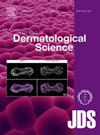Notch信号通路参与粘膜肥大细胞的分化和实验性食物过敏的发生
IF 4
3区 医学
Q1 DERMATOLOGY
引用次数: 0
摘要
本文章由计算机程序翻译,如有差异,请以英文原文为准。
Notch signaling contributes to differentiation of mucosal mast cells and development of experimental food allergy
求助全文
通过发布文献求助,成功后即可免费获取论文全文。
去求助
来源期刊
CiteScore
7.60
自引率
2.20%
发文量
98
审稿时长
9.1 weeks
期刊介绍:
Although the Journal is the official organ of the Japanese Society for Investigative Dermatology, it serves as an international forum for the work of all dermatological scientists. With an internationally renowned Editorial Board, the Journal maintains high scientific standards in the evaluation and publication of manuscripts. The Journal also publishes invited reviews, commentaries, meeting announcements and book reviews. Letters to the Editor reporting new results or even negative scientific data, if they contribute to advances in dermatology are encouraged. Letters to the Editor should be less than 1000 words with up to 2 figures or tables.

 求助内容:
求助内容: 应助结果提醒方式:
应助结果提醒方式:


